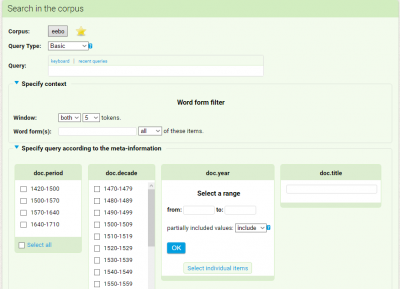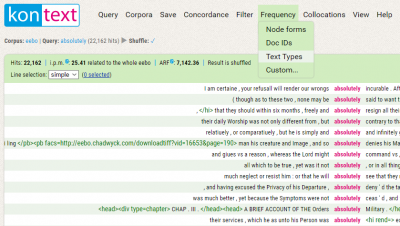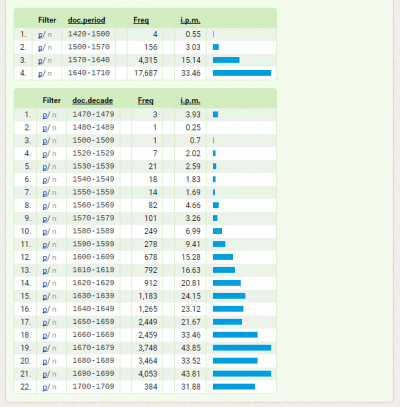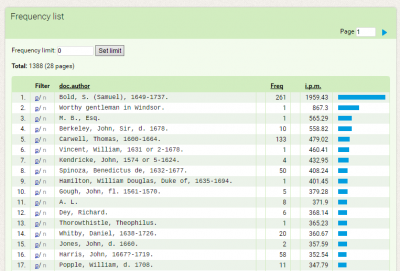Lesson 4: Specify query
In this lesson we will have a look at how we can further specify the query using various features of the KonText interface. EEBO is a historical corpus and therefore will be especially useful for diachronic searches that map how certain linguistic phenomena have developed over time.
Specify query according to the meta-information
We click on the KonText icon, so we can start a new query. We select EEBO for the corpus and a basic query type. At the bottom of the form we click on the Specify query according to the meta-information button and a menu will appear where we can place restrictions on the query. We can limit our search either to a specific period or even decade within which we wish to observe the wanted linguistic phenomenon.
Between the fifteenth and seventeeth century a great number of new words were introduced into the English language as a result of new inventions and radical changes in the society. These words were either coined by English writers or borrowed from other languages such as Latin and French.
One of such words is the verb ablegate which according to Oxford English dictionary was introduced into English in 1621. According to OED, the meaning of this archaic word is to send away. We can verify the date of the first use of this word in English easily using the EEBO corpus.
- If we select the period between 1420-1500, there will be no results in the concordance list, as the word was not used at that time yet.
- The same goes for the period between 1500-1570.
- After selecting the period 1570-1640, we get one result.
- On the left side of the concordance line, we can see that the text was written by Thomas Cooper.
- By clicking on his name, we can obtain even more information about the text. This piece of writing is from 1578. It is a Latin-English thesaurus which proves the word was still considered foreign at that time.
- In the period between 1640-1710, we get two hits. Both texts are written in English which confirms that by that time the word was part of the English lexicon.
- Using the EEBO corpus, we just proved the approximate date when ablegate was first used in the English language.
We can try to find out when the following words entered English and how their frequency increased or decreased over the years:
- absolutely
- convoy
- furnish
- precarious
Frequency
If we wish to see all of the frequencies of the word over the decades, we click on the Frequency button in the KonText interface and select Text Types in the dropdown menu. This way we will see all of the frequencies of a given word and how they increase or descrease over time. The upper chart shows frequencies across periods, while the bottom chart displays frequencies over decades.The frequencies of absolutely are sorted from the highest frequency to the lowest one. By clicking on the heading of the chart, we can change the order according to the period/decade, frequency or i.p.m.
In KonText menu, the item Frequency encompasses function for creating frequency distribution according to the document IDs. In the case of the EEBO corpus, we can sort the results according to the authors of the texts. If we want to know which writer used the word absolutely the most frequenly, we click on the Frequency button in the KonText interface and select Doc IDs in the dropdown menu. A similar chart than the previous one will appear, showing how often the given word occurs in the texts written by various authors. The results reveal that the word occured with the highest frequency in the writings of Samuel Bold, an English clergyman.
Task
- The word progress was borrowed from Latin in the fifteenth century. In which decades was this word most frequently used?
- To abstrude is an obsolete word nowadays. Can you infer its meaning from the EEBO concordance list?
- Find out who was the first one to use the word abstemiously?
By clicking on the name of the author located on the left side of the concordance line, a table will appear with the basic information about the text, including the date of publication.
If you are ready, you can continue to Lesson 5.



